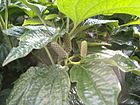Note: This is a project under development. The articles on this wiki are just being initiated and broadly incomplete. You can Help creating new pages.
Piper chaba
Piper chaba is a flowering vine in the family Piperaceae. It is native to South and Southeast Asia, Khulna Division of Bangladesh, Tripura , West Bengal in India. P. chaba is found throughout India and other warmer regions of Asia including Malaysia, Indonesia, Singapore and Sri Lanka.
Uses
Parts Used
Chemical Composition
It contains piperine, pipernonaline, guineensine, and the isobutylamide of 11-(3,4-methylenedioxyphenyl)undeca-2,4,10-trienoic acid.[1]
Common names
| Language | Common name |
|---|---|
| Kannada | Kandan Lippili |
| Hindi | Pipli |
| Malayalam | Tippali |
| Tamil | Tippili |
| Telugu | Pippallu |
| Marathi | NA |
| Gujarathi | NA |
| Punjabi | NA |
| Kashmiri | NA |
| Sanskrit | Pippali, Magadhi |
| English | Long Pepper, Indian long pepper |
Properties
Reference: Dravya - Substance, Rasa - Taste, Guna - Qualities, Veerya - Potency, Vipaka - Post-digesion effect, Karma - Pharmacological activity, Prabhava - Therepeutics.
Dravya
Rasa
Guna
Veerya
Vipaka
Karma
Prabhava
Habit
Identification
Leaf
| Kind | Shape | Feature |
|---|---|---|
| Simple | Ovate or oblong-oval | Leaves are numerous, 6.3 to 9.0 cm, dark green and shining above, pale and dull beneath. The older leaves are dentate, dark in color and heart shaped. |
Flower
| Type | Size | Color and composition | Stamen | More information |
|---|---|---|---|---|
| Bisexual | Flowers are monoceous and male and female flowers are borne on different plants. Male flower stalk is about 1 to 3 inch long and female flower stalk is ½ to 1 inch long. |
Other features
List of Ayurvedic medicine in which the herb is used
Where to get the saplings
Mode of Propagation
How to plant/cultivate
Irrigation is utmost essential during summer months. One or two irrigations in a week depending upon the water holding capacity of the soil, is needed.[3]
Commonly seen growing in areas
Photo Gallery
References
External Links
- Ayurvedic Herbs known to be helpful to treat Gastro-protective
- Ayurvedic Herbs known to be helpful to treat Anti-flatulent
- Herbs with Fruits used in medicine
- Herbs with common name in Kannada
- Herbs with common name in Hindi
- Herbs with common name in Malayalam
- Herbs with common name in Tamil
- Herbs with common name in Telugu
- Herbs with common name in Sanskrit
- Herbs with common name in English
- Habit - Herbs
- Index of Plants which can be propagated by Seeds
- Herbs that are commonly seen in the region of Lowland forest
- Herbs
- Piperaceae



